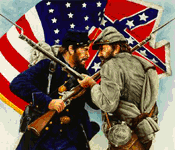 |
Civil War Battles |
|
State War Records |
| AL - AK - AZ - AR - CA - CO - CT - DE - FL - GA - HI - ID - IL - IN - IA - KS - KY - LA - MA - MD - ME - MI - MN - MS - MO - MT - NE - NV - NH - NJ - NM - NY - NC - ND - OH - OK - OR - PA - RI - SC - SD - TN - TX - UT - VT - VA - WA - WV - WI - WY |
The Battle of Wood Lake
September 23, 1862 in Wood Lake, Yellow Medicine County, Minnesota
 |
|||||||||||||||||||||
|
The Battle of Wood Lake was a battle in the Dakota War of 1862 in September. By that time in the Dakota War of 1862, the Sioux offensive had slowed considerably, and the Minnesota forces were beginning to implement a plan formulated by Governor Alexander Ramsey. Ramsey's plan, implemented by Colonel Henry Hastings Sibley and frontier commander Charles Eugene Flandrau, had the goals of freeing settlers held captive by the Indians and to "exterminate" or drive the Dakota "forever beyond the borders of the state".
Sibley attempted to negotiate a settlement with Chief Little Crow in early September, thinking that the Indians were growing weary of the war. Little Crow returned with an explanation of why the Indians started the war and hinting that he would consider negotiations about some United States prisoners they were holding captive. Sibley responded by refusing to negotiate and demanding Little Crow's surrender. Little Crow refused to surrender, and the conditions were set for another battle.
Sibley's initial expedition from Fort Snelling, which included 1400 troops, took nearly nine days to reach Fort Ridgely. At Fort Ridgely, Sibley delayed still further, to the frustration of settlers and others who wanted swift action against the Indian uprising. Jane Grey Swisshelm, a St. Cloud newspaper editor, wrote, "For God's sake put some live man in command of the force against the Sioux & let Sibley have 100 men or thereabout for his undertaker's corpse." The delay was caused, in part, by the lack of experience of the new recruits and the shortage of supplies, such as guns, ammunition, and horses. These supplies finally reached Sibley's forces between September 11 and September 14. On September 19, the troops finally began their march up the Minnesota River valley. The troops camped near Lone Tree or Battle Lake, about five miles north of what is now Echo, Minnesota. Sibley's guide thought the lake was Wood Lake, which was about three and a half miles to the west, so the battle is actually misnamed.
Little Crow planned to ambush the soldiers the next morning when they were marching along the road. In the morning, a few soldiers from the Third Minnesota regiment left camp early in search of food from the Upper Sioux Agency. When the Sioux ambushed the soldiers, they returned fire, and the rest of the soldiers from Sibley's camp advanced to aid their fellow soldiers. The fight lasted about two hours, during which Chief Mankato was killed by a cannonball.
The battle was a decisive victory for the United States, with heavy casualties inflicted on the Sioux. For his part in the battle, Sibley received a promotion to Brigadier General. The battle was also the last fought by the Sioux in the uprising, and it led to the release of those held captive by the Sioux and the capture of many of the Indians.
Books on The Battle of Wood Lake available From Amazon.com
